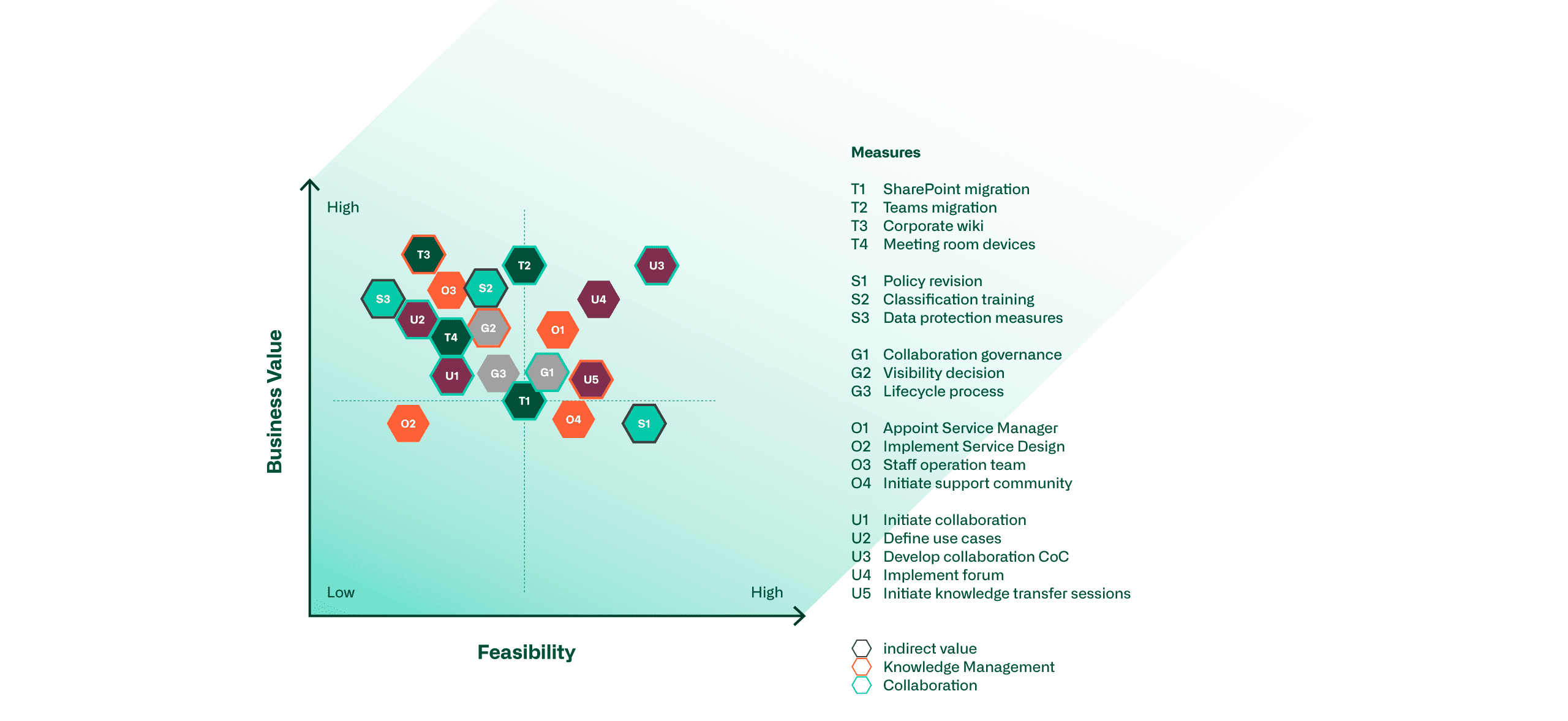Blog
Digital Work Collaboration & Productivity Tools implemented - now what?
Do management and employees know a) which tools to use and b) how to work?
Did you install a collaboration and/or productivity tool as a quick fix during Corona, but didn't roll it out? Then you're like many other companies.
Do these statements sound familiar to you and do you see yourself in one or the other situation?
- We have an internal chat tool, email, Microsoft Teams, etc. Now in which tool do I need to do what? Is it not possible to connect them?
- Where should I store my data? In Windows Explorer, in Teams in SharePoint on OneDrive, etc.?
- I spend a lot of time searching for news and documents because there are too many channels and tools.
- We have a desk phone, a soft client and now Microsoft Teams. Which of these "phones" should I work with?
- Do users use tools that IT doesn't even know about?

You are not alone with these problems!
The experience from our customer projects shows that at many customers the collaboration and productivity tools were implemented, but not or only partially effectively introduced.
Our customers, whether enterprise or KM companies, usually face the same challenges.
- The existing classic legacy telephony will continue to be operated.
- Skype for Business is deployed and there is no migration plan on how this will be replaced by the planned end of life date (9/1/2024).
- There are no company-wide guidelines and directives (corporate governance) on how to work with the new collaboration and productivity tools.
- There are other collaboration and productivity tools in the company, some of which have redundant functions and are not used consistently by everyone.
- Employees no longer know where to find their data and which channel/tool to use to edit what.
- There is no strategy or an inadequate strategy for how the company wants to work with the new opportunities for Digital Workplace, Cloud and Collaboration in the future.
All of these points, and many more, need to be considered when choosing the most appropriate collaboration and/or productivity tool and introducing it into the business.
Through Corona, many companies quickly rolled out one or even more collaboration/productivity tools without thinking about what they actually wanted to do with them and what benefits they hoped to gain.
In the beginning, it was just the need to communicate with each other when everyone works in the home office. However, most people quickly realized that these tools can do even more and that it is almost impossible to imagine everyday business without them. Nowadays, it is already a matter of course to send a Microsoft Teams or Zoom invitation without asking the person you are talking to if they also use it at home.
After 2 ½ years, it is apparent that many companies still do not have a strategy on how to deal with the new situation and the cloud, and how to use the new collaboration and productivity tools efficiently.
Shadow IT is growing!
Due to the fact that there are no clear guidelines, each employee tries to organize himself as much as possible and to make the best of his situation so that he can work with all the different tools. Most of the time, this ends up in the creation of a shadow IT in the company and thus can no longer be controlled.
Shadow IT
Shadow IT describes systems, such as cloud services and applications, that are used and operated by employees without the IT department knowing about them and therefore being unable to protect them.
This inevitably leads to various risks that arise as a result.
Here are just a few examples:
- duplicate license costs or insufficient overview of them
- breaches of data protection, mostly due to ignorance of the legal basis and data retention guidelines
- access by unauthorized persons to sensitive data
- loss of data due to insufficient data backup or when an employee leaves
How can they counteract these circumstances?
When introducing a new collaboration or productivity tool, it is important that a few points are defined and the rules of the game are clear to everyone.
Compliance
The existing IT security policies are usually no longer sufficient for the new use cases such as cloud collaboration. For example, collaboration with external parties and the use of cloud storage for confidential documents are often not or insufficiently regulated.
Help your employees make the right compliance decisions by defining and communicating them clearly.
Governance
Governance policies and processes must also be defined to ensure that working with collaboration and productivity tools adds value and does not lead to uncontrolled growth or compromise efficiency.
Here are a few examples for MS Teams
- Is there a need for naming conventions?
- Who is allowed to open new teams / channels?
- Who can add users to teams?
- Are guests allowed to be added to the teams?
- Which apps are allowed to be used within teams?
- What retention policies should be defined?
- Is there a need for regular review of authorizations for internal and external (lifecycle management)?
User adoption
In addition to defining the compliance and governance guidelines, users must be informed and trained. Ideally, there are regular repetitions and, for example, a training platform or a wiki so that new employees are also trained and can access the information. This is the only way to ensure that employees use the tools profitably and in accordance with the guidelines.
How can we support you in your project?
Thanks to our experience in the various topics, we can help you identify the stumbling blocks and clear them out of the way. With our standardized "Digital Work Collaboration: Maturity Check", we check where you currently stand in the introduction of collaboration and productivity tools and in which areas you still have potential for improvement.
As a result, we create a heat map with the vectors feasibility and benefit. This shows in which areas the greatest potential for improvement and what can be profitably implemented.

Of course, the "Maturity Check" is not the end of the story.
The Maturity Check is an instrument for an initial rough assessment of the current situation. After this, the actual work for your company really begins. Now it is time to gather all the requirements of the departments and, based on these, to develop an appropriate cloud strategy and to create guidelines for handling the collaboration and productivity tools provided. We are also happy to support you in the subsequent steps, whether in the area of evaluation of video room solutions, in finding the right cloud strategy for you or in the introduction in the company.





